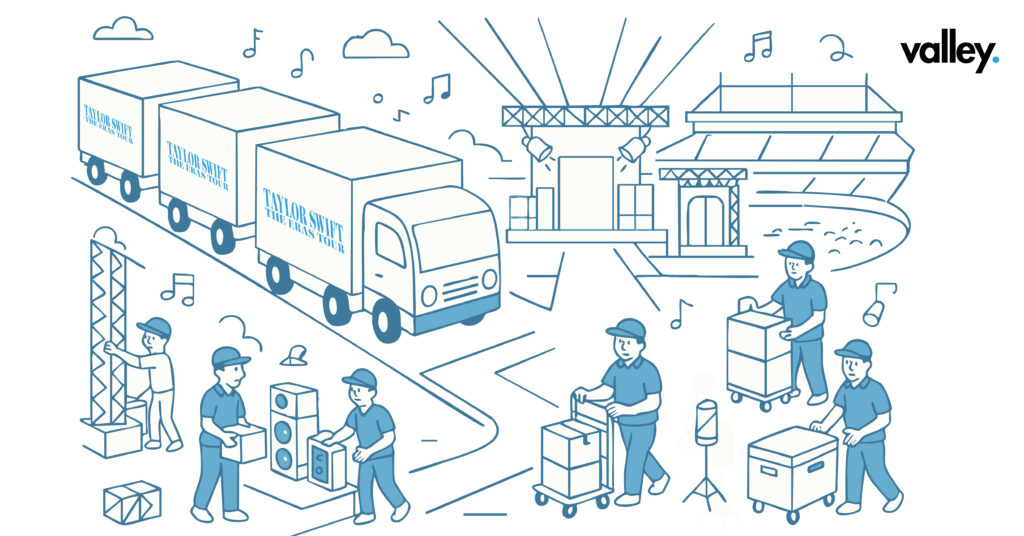How Trucking Logistics Moved Taylor Swift Eras Tour

Let’s explore how trucking logistics moves the Taylor Swift Eras Tour. The Taylor Swift Eras Tour is one of the most ambitious live productions ever staged. It broke global records for ticket sales and drew millions of fans to stadiums across continents. Behind every light, sound, and costume change stands a powerful network of truckers who move the show from city to city with precision.
Quick Answer
The Eras Tour depends on more than 90 trucks to carry staging, lighting, sound gear, and costumes between venues. Success relies on strict scheduling, skilled drivers, and flawless coordination. Every delivery must arrive on time and in perfect condition to rebuild a full stadium setup overnight.
Why It Matters
Concert tours like this are not only entertainment. They are massive supply chain operations. Each performance is like constructing a temporary city that must be built, operated, and dismantled within days. Truckers sit at the center of it all. Their work mirrors what logistics companies do every day, moving time-critical, high-value freight safely and efficiently.
As CNBC reported, the Eras Tour became a multibillion-dollar global enterprise, generating more than 4.6 billion dollars in economic activity across cities. That success would not be possible without a transport system that works with military-level precision.
The Scale of the Taylor Swift Eras Tour Operation
The tour’s logistics read like a masterclass in coordination.
- Over 90 semi-trucks transport equipment between U.S. and international stadiums.
- Each truck carries a dedicated load, from stage props and instruments to LED screens.
- Hundreds of crew members handle setup and teardown alongside the drivers.
- Routes are planned months in advance, with backups for weather or border delays.
According to BBC News, each city setup requires three days, while teardown and travel happen in less than one. The trucks move in convoys, often driving overnight so the next stage rises by morning.
Real-World Example: From Stadium to Stadium
When the tour finishes a show, hundreds of crew members begin dismantling the stage within minutes. Dozens of trailers are loaded with lighting, sound rigs, costumes, and steel structures. Drivers then head out in coordinated convoys, covering hundreds of miles through the night. By the time fans arrive at the next city, the stage is rebuilt, tested, and ready.
This model of nonstop logistics was described by the Los Angeles Times, which covered how precise truck timing underpins each leg of the production.
The Impact on Drivers on Taylor Swift Eras Tour
Truckers play one of the most demanding roles in live touring.
- Long hours: Overnight drives between stadiums under tight schedules.
- Specialized cargo: Fragile, custom equipment needing careful handling.
- Coordination: Drivers work directly with electricians, stage crews, and managers.
- Recognition: In 2023, Taylor Swift gave each driver a 100,000-dollar bonus as a thank-you for their role in keeping the tour running smoothly.
That gesture, covered widely by multiple outlets, underscored the vital link between the trucking community and the entertainment industry.
Lessons for Logistics and Supply Chain Management
Business leaders can learn from the Eras Tour playbook.
- Precision scheduling: Every truck has a defined arrival and loading window.
- Backup planning: Alternate routes and spare units prevent downtime.
- Communication: Coordination between crews, drivers, and management avoids confusion.
- Flexibility: The team adapts instantly to weather, traffic, and technical issues.
These same principles apply to freight carriers, construction projects, and any supply chain dependent on timing and reliability.
Common Mistakes Avoided by Tour Operations
- Overloading drivers without adequate rest periods
- Poor communication between departments
- Failing to plan for contingencies or emergency rerouting
- Ignoring data tracking and feedback loops after each move
The Eras Tour avoided these pitfalls through planning, respect for drivers, and real-time collaboration.
FAQs
How many trucks does the Eras Tour use?
- More than 90 trucks haul stage materials, lighting, and costumes between venues.
Do the same drivers complete the entire tour?
- Yes. Many drivers stay for the full duration, forming part of the touring crew.
What makes tour trucking different from standard freight?
- The schedule is non-negotiable. The load is fragile, and timing links directly to live events.
What can logistics teams learn from this?
- Plan ahead, build redundancy, and invest in coordination tools.
How did Taylor Swift reward her trucking crew?
- She awarded each of them 100,000 dollars in appreciation for their work.
Final Thoughts
The Taylor Swift Eras Tour logistics story shows how large-scale operations depend on precision, respect, and teamwork. With over 90 trucks moving gear between stadiums worldwide, this operation proves that great logistics power great moments.
For trucking fleets and logistics professionals, the takeaway is simple: plan early, coordinate constantly, and value the people who make it possible.
